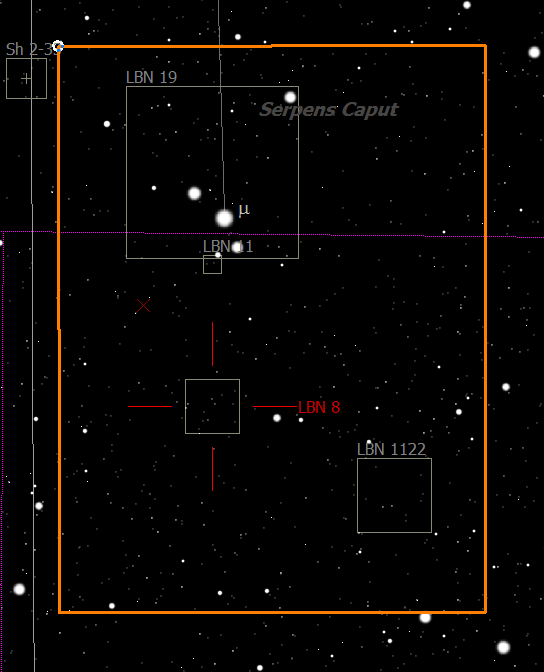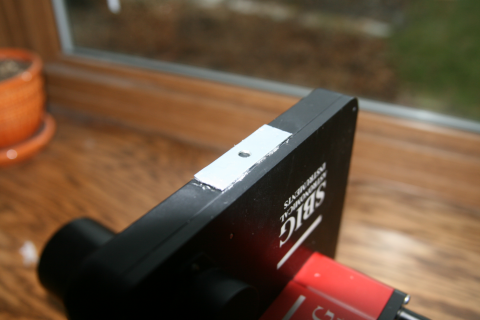Some nights are great. All the hardware works just like it's supposed to, the weather cooperates, and you end up with a fine image. Then there are nights like last night.
How it went:
Finder and C925 axes aligned using Venus. No problem.
Polaris was still visible through the leafless tree branches (it won't be in a couple of weeks) and I could use my polar scope to get me approximately aligned. Then I fired up PHD2 and that got me a much better alignment.
Now which to image first? Dwarf planet Orcus or dwarf galaxy Leo I? Fire up Sky Tools and figure it out. But wait, Orcus isn't in the list of Dwarf planets like it is on my desktop PC. Fix: Download the data. No: WiFi signal is too weak in the back yard. Bring Laptop inside, still won't connect. Seems it has forgotten the network password, as have I. Look up PW, get laptop on the Internet. Download dwarf planet observing list. Still no Orcus. Go through Supplemental data area for the update, still no luck.
Create a SkyTools synch backup from my desktop, which takes almost five minutes for some reason. Load the synch onto the laptop, and there's Orcus. Go back outside.
Decide that Leo I is first. Navigate to Regulus. Begin to refine focus. Whoa: Stars are way out of round and any sort of reasonable focus is impossible. Obviously the C925 needs collimation. Mine came with Bob's Knobs from its previous owner, so I tweak one of the knobs and hope for the best. This initially makes it much worse, but eventually I walk it back to as bad as it was.
I begin to wonder if this is a problem with the focal reducer. I remove that from the optical path and try focusing again. No improvement, and now I've got an even smaller field of view to work with.
More playing with Bob's Knobs to no avail. I discover that the secondary's lock ring is loose
and that the secondary can be spun around. Really not good.
At this point it dawns on me that there won't be any imaging. In desperation I get Leo I composed and shoot a 300s light frame binned 2x2. All I get is an overexposed field full of really horrible looking stars. The sky is too bright?
Yes, it is. I shoot another frame unbinned and get a better background. But where the dwarf galaxy is supposed to be is only darkness, even after the usual stretching. The sky is simply too bright.
So Leo I is off because of collimation and sky brightness, and Orcus can be forgotten because of the poor alignment. Evening over.
Imaging can be fun, but not when one doesn't pay attention to details.
One other detail I let slide was on the satellite loop. During the late afternoon it was obvious that what looked like a wide layer of smoke was moving northward out of Iowa and Missouri. I've seen smoke obliterate the view at a dark site, and over the light dome of the city it lit up to make imaging difficult if not impossible. My backyard limiting magnitude is typically 4 to 4.5; last night I estimated it to be around 3.0.
Tonight I collimated my C925 using the
Hubble artificial star light, a really slick little LED flashlight with a precisely drilled mask. I also read up on the process of
collimation at Starizona. Interesting to me was what Starizona said about Bob's Knobs:
In our experience, the original screws on an SCT secondary mirror
are much better to use for collimation purposes than the aftermarket thumbscrews
that can be added. Thumbscrews cannot be turned as precisely, making
accurate alignment difficult. Also, thumbscrews do not hold the mirror as
tightly, increasing the need to collimate more often. Thumbscrews also
tend to make people "collimation happy," tending to collimate a scope far more often
than necessary. Under normal use, you should be able to go months without
collimating a telescope.
I removed the Knobs, snugged the locking ring, and collimated just fine. I have nothing against the product, but I can definitely relate to the idea of them tempting someone into being "collimation happy." I think I achieved "collimation loony" last night.
The weather service AND the CSC says that tomorrow night will be gloriously clear here, so I'll try again.
Maybe things will go a little better?












